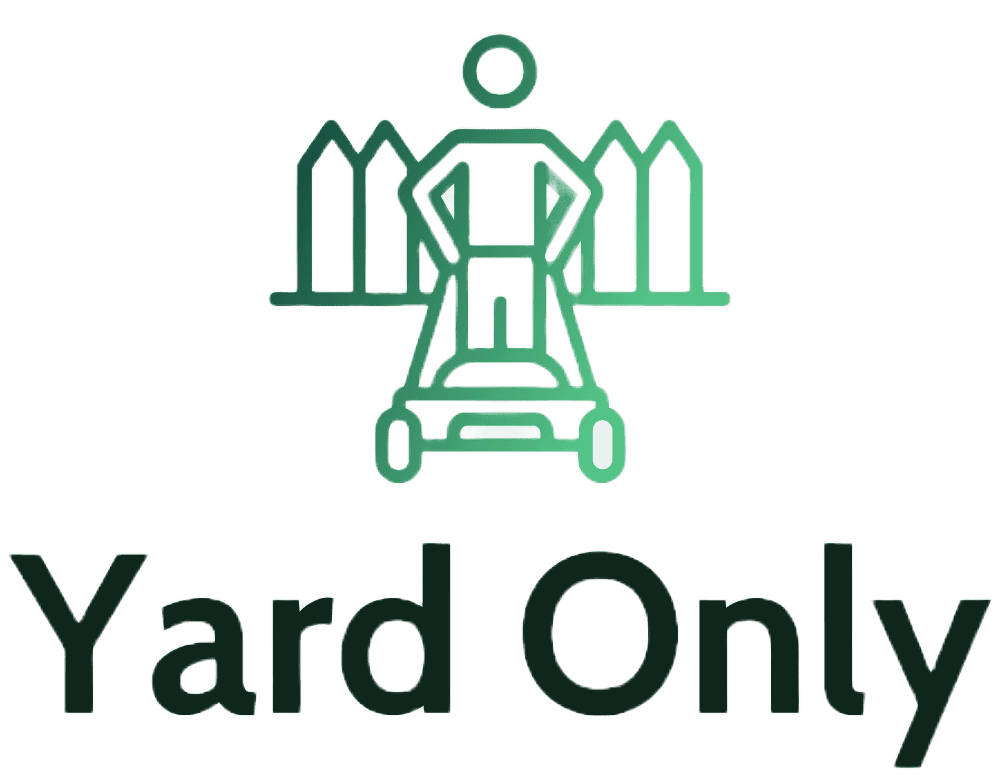Ideally, a trampoline needs to be placed on a leveled surface. However, all backyards are not uniformly leveled with several troughs and ridges. Moreover, a few backyards have a slope, making it difficult to set a trampoline.
Though difficult, it’s not impossible to set a trampoline on a slope. There are numerous ways to install the trampoline on a slope. Commonly you can dig trenches, use leveling kits or blocks, or level the surface by filling soil at the lower areas.
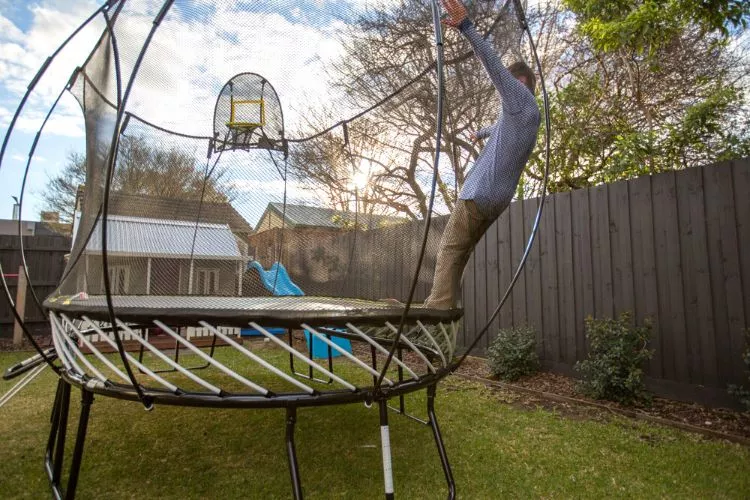
Can you put a trampoline on a slope?
Though a trampoline works ideally on a flat surface, you can put it on a slope. You will have to do a few modifications to your backyard for that.
Care should be taken while jumping on a trampoline set on flat ground. However, extra care must be taken for a trampoline on a slope. The slope poses additional risks for anyone falling off the trampoline.
Individuals falling off the trampoline not only hurt themselves and others in the vicinity too. In addition, they won’t be able to prevent them from rolling downside across the slope. A safety net must be installed to avert such kinds of mishaps.
Moreover, it will put additional stress on the trampoline springs and mat, leading to quick damage. The trampoline may not be stable on uneven grounds and slopes, making it unstable and ready to tip over, causing grave injuries to the bouncer.
Alternatives to put a trampoline on a slope
Now that you understand it’s risky to use a trampoline on a slope. However, you won’t get a leveled ground with a uniform surface all over. Mostly, you will have to deal with uneven ground.
So, will you pack up the trampoline and dump it in your garage or attic? No, right? So let’s understand how to place a trampoline on a slope.
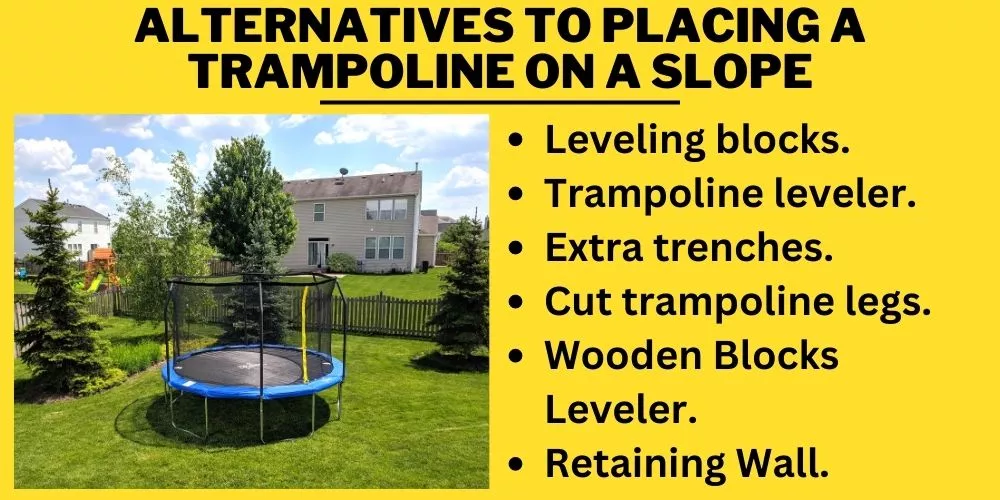
1. Leveling blocks
Leveling blocks are a great alternative. They are available in many variants. Even though they are built for RVs and cars and not dedicatedly to trampolines, you can use them to level your trampoline.
Leveling blocks are simple to use. You need to place them underneath the lower part of the trampoline’s legs to lift it up to level with the other part. Leveling blocks are an affordable option.
2. Trampoline leveler
A trampoline leveler is another superb option. They basically add to the trampoline legs as their extension. It allows you to raise or lower the levels to align them equally to attain an ideal balance.
3. Extra trenches
Building a trench on a slope is another option to level your trampoline. You might have to put in extra effort, but bouncing on the trampoline will be fun. You may have to plan whether you want to set the trampoline above the ground entirely. Or want to conceal a specific trampoline part underneath to level it.
If you want that specific trampoline part underneath, start digging the soil. Mind you, you are required to put in a lot of work to get that done. If you decide to keep your trampoline above the ground, you may need to raze off the elevated part in the yard to level it with the rest of the base.
4. Cut trampoline legs

You can use this option only if you decide the install the trampoline to never move it again to another location. Moreover, this option needs a high level of skillful handling with tools like a saw for cutting the legs and drills to hole the legs as required.
5. Wooden Blocks Leveler
Wooden blocks are another option to level your trampoline. They are an affordable and straightforward option for installing a trampoline on a slope. Arrange the wooden blocks vertically to attain the desired height.
Another way is to ground the wooden blocks onto the soil. Once you set the trampoline legs on the wood plank, secure the base by fastening the legs with clamps or similar accessories.
6. Retaining Wall
Building a wall on the trampoline’s lower side helps to align the trampoline appropriately. It’s one of the best options to secure a trampoline on hills and steep slopes. Make the wall using wood or rocks along with the soil. Remember, the height of the wall shouldn’t be more than four feet.
Safety measures
Now that you know how to adjust your trampoline on an uneven area or slope, it’s time to focus on safety to secure yourself from any unseen event.
- Ensure the area around the trampoline is clear. No structure or object should be close to your trampoline.
- Ensure you don’t set your trampoline beneath a tree.
- Trampolines must be installed away from pools, houses, and pets.
- Place a safety net and spring cover.
- Use trampoline anchor kits to secure your trampoline onto the ground.
Special Considerations To Put A Trampoline On A Slope
Considering a few factors before placing your trampoline on a slope helps you to enjoy it safely and securely. Let’s look into the details.
Anchoring of trampolines
Mandatorily anchor the trampoline to the ground before bouncing on them. When you jump on the trampoline, it’s natural for it to move or shake. Not anchoring the trampoline may lead to hurting the bouncers and damaging the trampoline.
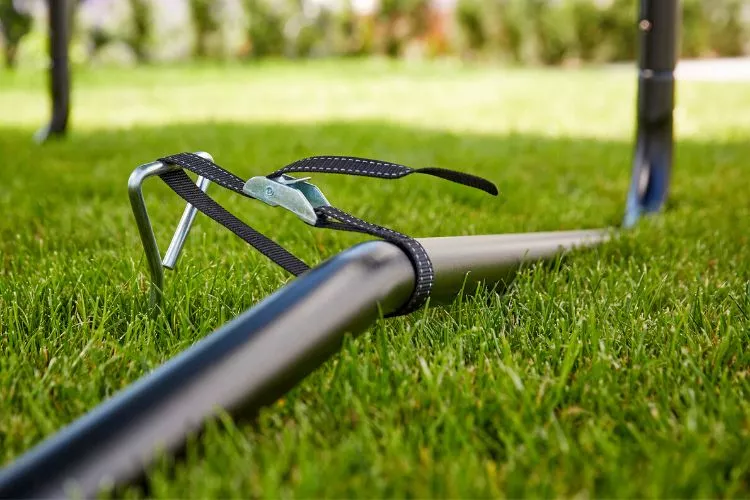
On a slope, the trampoline may roll down, possibly with bouncers playing in, if not anchored. Moreover, in the case of a stormy day, the trampoline may blow away with the wind.
Trampoline pads
Trampoline pads make essential accessories. The trampoline has springs and a frame that may injure the kids if they crash on it.
Trampoline pads protect the kids by preventing them from hitting their heads and arms and fit onto the springs and the frame. Ensure the pads are in the best usable condition and don’t compromise your kids’ safety.
Inspect and maintain the trampoline and its accessories regularly
Ensure you take good care of your trampoline to increase its longevity. Herewith are a few tips to help you with that.
Keep it clean:

- Remove any twigs, pebbles, dirt, debris, or leaves before you use them. Remove the dust with a soft brush. Avoid using a stiff brush as it can damage the mat.
- You can also wash the trampoline if needed. Wash it with warm water with a soft detergent and a soft brush. Flush off the soap with plenty of water, wipe out the frame and leave the trampoline to dry in the air.
- Winterize your trampoline in winter. Remove all the net poles, enclosures, and jumping mats and store them in a clean and dry area. If you choose to keep it outside, anchor the frame down. Ensure you dust off any snow built-up as it can sag the mat and adversely impact the bounciness.
- In spring, check for any indications of wear and tear for the trampoline and its accessories. Possible signs are holes in the enclosures or mat, damaged zipper, rusty frame, and distorted or missing spring. You must replace the damaged parts before using the trampoline.
- Check the springs and frame after heavy rainfall in summer and autumn. You might notice leaves or twigs trapped in a few components of the trampoline. Rid those and wipe the affected part to dry them.
How do you anchor a trampoline on a slope?
Anchoring a trampoline on a slope requires a little effort to be put in. Let’s understand what they are.
Identifying the slope
The first and foremost step is to measure the slope in your backyard. You will require the following tools.
- Shovel
- Measuring Tape
- Carpenter’s or a laser level
- Trampoline assembly tools:
- Spring puller
- Hammer
- Gloves etc
- Trampoline leveler or
- Leveling kit
- Large wood plank (equal to the trampoline’s diameter)
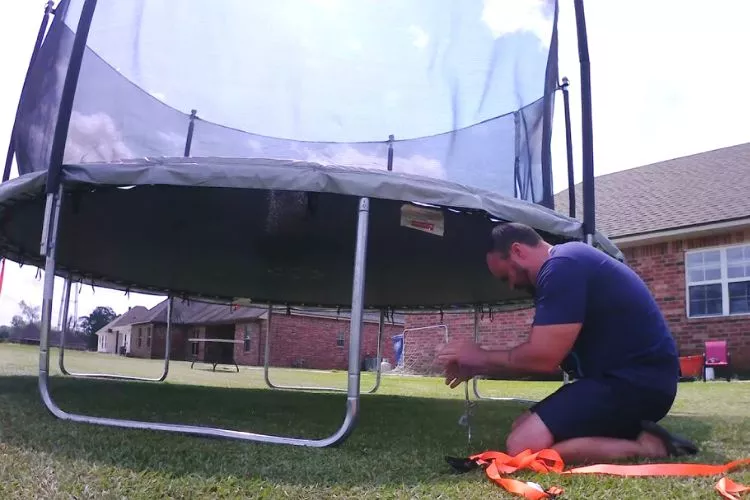
Herewith are the steps:
- Place the assembled trampoline in the area where you wish to install it.
- Place the wooden plank on the trampoline bed.
- On the upper side of the wooden plank, set the carpenter’s level.
- Lift the lower side of the wooden plank. Go on raising the level till the bubble on the carpenter’s level is stable.
- The stability of the bubble indicates both ends are on an equal level.
- Measure the distance between the plank’s top and the trampoline bed. Name this distance as (y).
- Divide (y) by the trampoline’s diameter. Name the diameter as (x).
- y divided by x is the slope.
- If it is higher than 7, it’s a major slope, indicating a steep slope and unsafe to set the trampoline there.
- Identify a slope measuring less than 7 (minor slope), and install the trampoline in that area.
Note: A laser level can quickly identify the type of slope in a few seconds.
Do trampolines need to be on flat ground?
Though recommended, you won’t find an ideal flat ground. Having ground covered with concrete is a different story. But most backyards have an uneven surface with a slope (minor or major).
But having a flat ground is safer for the bouncers. It’s much easier to bounce. The stability a flat ground provides is much better than that of uneven ground. The stability helps provide substantial tension for a high jump and stable landing, allowing the bouncers to have fun, safely and securely.
Installing a trampoline on flat ground is recommended. However, you can still use it on uneven ground with the alternatives given above.
Other trampoline related articles: Does Jumping On A Trampoline Make You Taller? | How To Keep Trampoline From Blowing Away?
Conclusion:
Trampolines are the best tools to enjoy in your backyard with your family. But they need to be installed on a flat surface or uniformly leveled ground, which is a rare possibility. However, that doesn’t stop you from enjoying them.
There are ways to enjoy trampolines in backyards with uneven surfaces or slope too. By putting in some effort, you can adjust your trampoline to make it workable on an area with a slope too. Ensure you follow all safety measures before using trampolines, to enjoy them to the fullest.
